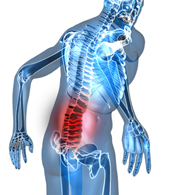If you’ve ever suffered from really bad lower back pain, then you know how it can be debilitating, and mind altering, and not in a good way. Even the simplest of daily tasks such as walking or standing up from a chair can be a challenge. Many times, lower back pain and injuries are caused by a variety of factors, but many of the major culprits are muscle weaknesses and muscle imbalances.
Kettlebells exercises and routines can help fix those imbalances and weaknesses and help to eliminate back pain. Before we look at how kettlebells can help, lets look at some of the common weaknesses and imbalances.
1. Weak Abdominals. When your abs are working properly, they help keep your pelvis from moving too much or into the wrong positions when moving, whether it’s regular moving or exercising.
2. Tight Hip Flexors. The hip flexors allow you to walk, run, climb, stand, sit, lunge, twist, and turn. When these muscles tighten up, they pull the pelvis out of its natural alignment. If your abs are weak, it can become a major problem, especially if the hip fexors are tight. Tight hip flexors prevent the abdominals from working correctly, and therefore start to cause even more problems.
3. Weak Butt. The Buttocks are designed to help you move forward and provide a counterbalance when bending. When this muscle group is weak in combination with the others, it can be a real pain in the butt, as well as trouble for the lower back.
4. Weak Hamstrings. These are the muscles that run down the back of your legs and are designed, along with the butt, to move you forward. They too provide a counterbalance to your upper body when bending.
There are of course other muscle areas that can contribute to back pain, but these are some of the main areas of concern.
Basic kettlebell exercises such as the Deadlift and the Swing will strengthen the weak areas such as the buttocks, abdominals, and hamstrings. Doing kettlebell exercises will help to correct these musculoskeletal imbalances over the course of time.
Most kettlebell exercises focus on the hips and core muscles, but when performed correctly, they literally have a magical effect on the body. Not only do tight hips from years of sitting loosen up, become stronger and more resilient, but for some with old shoulder injuries, they tend to disappear as overly-mobile and weak shoulders become more stable.
One key factor in performing Kettlebell exercises is doing movements through a full range of motion.
Many of the exercises work the muscles of the posterior chain (our back, gluts or buttocks, hip flexors, hamstrings) extremely well, and when done correctly, promote the need to use these muscles efficiently, and effectively!
One of the biggest contributing factors to many back injuries is from long periods of sitting, during which muscles shorten and weaken, they become tight and more susceptible to pain and injury. One false move and BAM! Back Pain!
By incorporating kettlebells into your workout program, your muscles learn to work properly again, gain strength and as such, become more supportive, more flexible and able to work safely through greater movement ranges.
Before using kettlebells or any other exercise program, especially if you have a history of lower back pain or injury, you should do two things:
1. Consult the physician in charge of your pain and/or injury.
2. Find a skilled, certified kettlebell instructor to show you how to perform each exercise in the safest, most effective manner possible for your background. They will show you proper form and technique so you get the most out of your workout, and so you don’t injure or re-injure yourself.
Finally, once you have met the above two conditions, take your time with the kettlebell training. Keep the mindset of “training”, like an athlete training for an event, and not the mindset of “working out.” You want to train and build good movement patterns, technique and form to get the most out of your training and you out of pain.







